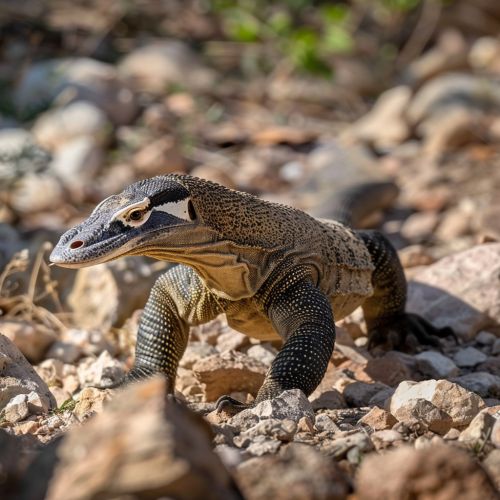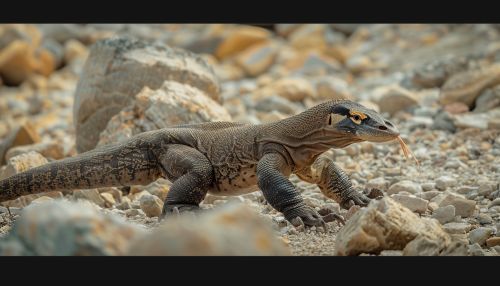Monitor Lizard
Introduction
Monitor lizards are a diverse group of reptiles belonging to the genus Varanus. They are known for their elongated bodies, well-developed limbs, and long tails. These lizards are found in Africa, Asia, and Oceania, with the highest diversity in Southeast Asia. Monitor lizards are known for their intelligence, complex behavior, and adaptability to various habitats.
Taxonomy and Classification
Monitor lizards belong to the family Varanidae and the genus Varanus. The genus Varanus is divided into several subgenera, including Empagusia, Euprepiosaurus, Odatria, Papusaurus, and Varanus. There are approximately 80 recognized species of monitor lizards, ranging from the small short-tailed monitor (Varanus brevicauda) to the large Komodo dragon (Varanus komodoensis).
Morphology and Physiology
Monitor lizards exhibit a wide range of sizes and shapes, but they share several common morphological features. They have elongated bodies, strong limbs, and long, muscular tails. Their skin is covered in small, granular scales, and they possess sharp claws and teeth. Monitor lizards have a forked tongue, similar to that of snakes, which they use for chemoreception.
Size and Growth
The size of monitor lizards varies significantly among species. The smallest species, such as the Dampier Peninsula monitor (Varanus sparnus), can be as small as 20 cm in total length, while the largest species, the Komodo dragon, can reach lengths of up to 3 meters and weigh over 70 kg. Growth rates and patterns also vary, with some species exhibiting rapid growth during their juvenile stages.
Reproductive Biology
Monitor lizards are oviparous, meaning they lay eggs. The number of eggs laid varies by species, with smaller species laying fewer eggs and larger species laying more. For example, the savannah monitor (Varanus exanthematicus) can lay up to 50 eggs in a single clutch. The eggs are typically buried in soil or hidden in vegetation, and the incubation period can range from a few months to over a year, depending on environmental conditions.
Behavior and Ecology
Monitor lizards are known for their complex behaviors and adaptability to different environments. They are primarily carnivorous, feeding on a wide range of prey, including insects, small mammals, birds, and other reptiles. Some species, such as the water monitor (Varanus salvator), are also known to scavenge.
Foraging and Feeding
Monitor lizards are active foragers, using their keen sense of smell and vision to locate prey. They are known for their ability to track and capture prey with precision. Some species, such as the Nile monitor (Varanus niloticus), are excellent swimmers and can hunt both on land and in water. Their diet is diverse and can include carrion, which they locate using their highly developed sense of smell.


Social Structure and Communication
Monitor lizards exhibit a range of social behaviors, from solitary to more social species. They communicate using a combination of visual signals, chemical cues, and physical interactions. For example, males may engage in combat displays to establish dominance and secure mating opportunities. These displays can include head bobbing, tail whipping, and biting.
Habitat and Distribution
Monitor lizards inhabit a wide range of environments, from arid deserts to lush rainforests. They are highly adaptable and can be found in terrestrial, arboreal, and aquatic habitats. Their distribution is primarily in the Old World, with species found in Africa, Asia, and Oceania. The Komodo dragon is endemic to a few Indonesian islands, while the lace monitor (Varanus varius) is native to Australia.
Conservation and Threats
Many species of monitor lizards are facing threats due to habitat loss, poaching, and the illegal pet trade. Some species, such as the Komodo dragon, are listed as vulnerable or endangered by the IUCN. Conservation efforts are underway to protect these species and their habitats, including habitat restoration, anti-poaching measures, and captive breeding programs.
Habitat Loss
Habitat loss is one of the most significant threats to monitor lizards. Deforestation, urbanization, and agricultural expansion have led to the destruction of their natural habitats. This loss of habitat not only reduces the available space for these lizards to live and hunt but also fragments populations, making it difficult for individuals to find mates and maintain genetic diversity.
Poaching and Illegal Trade
Monitor lizards are often targeted for their skin, meat, and as exotic pets. The illegal trade in monitor lizards is a significant problem, with many species being captured and sold in international markets. This trade is often unsustainable and can lead to population declines. Efforts to combat this trade include stricter enforcement of wildlife protection laws and increased awareness of the impact of the illegal pet trade.
Research and Studies
Monitor lizards have been the subject of numerous scientific studies due to their unique physiology, behavior, and ecological roles. Research has focused on various aspects, including their thermoregulation, reproductive biology, and cognitive abilities.
Thermoregulation
Monitor lizards are ectothermic, meaning they rely on external sources of heat to regulate their body temperature. Studies have shown that they use a combination of behavioral and physiological mechanisms to maintain optimal body temperatures. For example, they may bask in the sun to raise their body temperature or seek shade to cool down. Some species, such as the desert monitor (Varanus griseus), have adapted to extreme temperatures by becoming more active during cooler parts of the day.
Cognitive Abilities
Monitor lizards are known for their intelligence and problem-solving abilities. Research has demonstrated that they can learn from experience, remember locations of food sources, and even use tools. For example, the Komodo dragon has been observed using its tail to knock down prey from trees. These cognitive abilities are thought to be linked to their complex social structures and foraging behaviors.
